New system for technique improvement
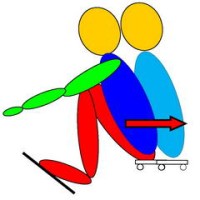
How does rowing on the erg affect technique in the boat? Discussions on this topic are quite popular in the rowing community. Some coaches think that erging is harmful for on-water technique for a number of reasons, but others believe that there is no big difference between technique in a boat and on an ergometer. Of course, the rowing machine is not a boat and the biomechanics of technical details are quite different (RBN 2005/03, 2009/06). However, the basics are very similar, such as the sequence of body segments (legs-trunk-arms), coordination of movements at the catch and finish. Therefore, a rowing machine could be successfully used for improvement of the most important basics of rowing technique, and then transferring them into a boat.
The three most typical mistakes in rowing technique, which have the largest impact on performance, can be seen and corrected both on-water and on the rowing machine:
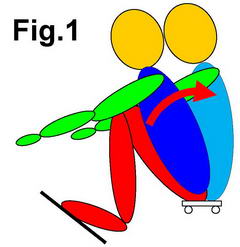 1. “Rolling” with the trunk at the catch “locks” the knees at their sharpest angle, which makes it really hard for the quads, stops rower’s CM (in global coordinates), increases variation of its velocity and inertial losses of energy. Also, this could be harmful for knee joints.
1. “Rolling” with the trunk at the catch “locks” the knees at their sharpest angle, which makes it really hard for the quads, stops rower’s CM (in global coordinates), increases variation of its velocity and inertial losses of energy. Also, this could be harmful for knee joints.
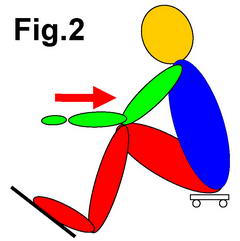 2. “Grabbing” arms and shoulders during the first part of the drive, or too early “opening” of the trunk activates smaller arm muscles and limits utilisation of powerful leg muscles and trunk. Arm ligaments and joints could be overloaded and injured.
2. “Grabbing” arms and shoulders during the first part of the drive, or too early “opening” of the trunk activates smaller arm muscles and limits utilisation of powerful leg muscles and trunk. Arm ligaments and joints could be overloaded and injured.
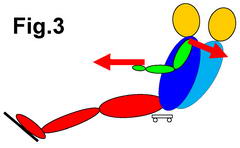 3. “Throwing” the trunk after the finish of the drive (prolongation of shoulder movement to the bow, when the handle has already changed direction and moves to the stern) means that trunk’s kinetic energy was not utilised into blade propulsion, but was lost inside rower-boat system. This overloads the stomach muscles, and could be the reason of rib stress fracture at high rates.
3. “Throwing” the trunk after the finish of the drive (prolongation of shoulder movement to the bow, when the handle has already changed direction and moves to the stern) means that trunk’s kinetic energy was not utilised into blade propulsion, but was lost inside rower-boat system. This overloads the stomach muscles, and could be the reason of rib stress fracture at high rates.
Our new BioRowTech system was developed on the basis of the previous Catch Training System (RBN 2016/05). Now, it has been converted into a complete instrument for rowing technique analysis and correction. It measures three variables: positions of the handle, seat and trunk (at the level of the shoulder joint). The encoder that measured the handle position in the previous version was replaced with a wire sensor, which gives more accurate data and is easier to install. Velocities of the legs (seat), trunk and arms are derived from measured positions and are used in quite sophisticated analysis, which produces the following three indicators displayed instantly for a rower:

1. Catch Factor is the time between the moments of stopping the handle and the seat at the catch. The optimal value is -25ms (-0.025s): by this time the seat should overtake the handle at the catch, which allows use of legs for the initial movement at the catch and the acceleration of the rower’s mass. Positive values (red zone) mean “rolling back” with the trunk, or “grabbing” the arms and shoulders; extremely negative values below -50ms (blue zone) means “slide shooting” at the catch and losses in leg power.

2. Rowing Style Factor is the ratio of the seat travel to the handle travel during the first 20% of the drive length (from catch till “transition point”, RBN 2015/10). The optimal value is 90%, which means only 10% of the handle movement should be provided by upper body, and the main contribution should come from the legs. Values lower than 80% (red zone) mean “grabbing” arms/shoulders or too early “opening” of the trunk. Values higher than 100% (blue zone) mean legs are going off too fast (“bum shoving”) and losing the power through a “weaker” back.

3. Finish Factor is the time between the moments of stopping the trunk and the handle at finish. The optimal value is -50ms (-0.05s). By this time the “return” of the trunk should overtake the stopping handle. Positive values (red zone) mean “throwing” the trunk after finish; negative values lower than -100ms (blue zone) mean “winding trunk around the handle” and losses in trunk power at finish.
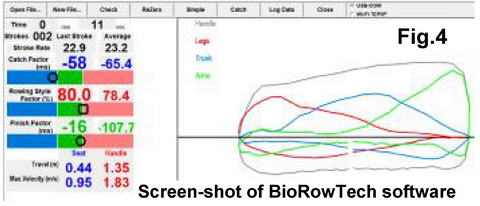
New BioRowTech system is quite a simple, but effective tool for rowing technique improvement for rowers at all levels. For experts, it gives a lot of detailed information, such as the contribution of body segments into total stroke length, values and curves of segment’s velocities, etc. (Fig.4). The system works with a modified BioRowTel software under Windows, which allows recording data samples, producing average curves, and analyse differences between various rowers and data samples.
With our Oar Angle sensor, the BioRowTech system can work in a boat as well. Please look for more information in BioRowTech system for erg in Products section of our website.



